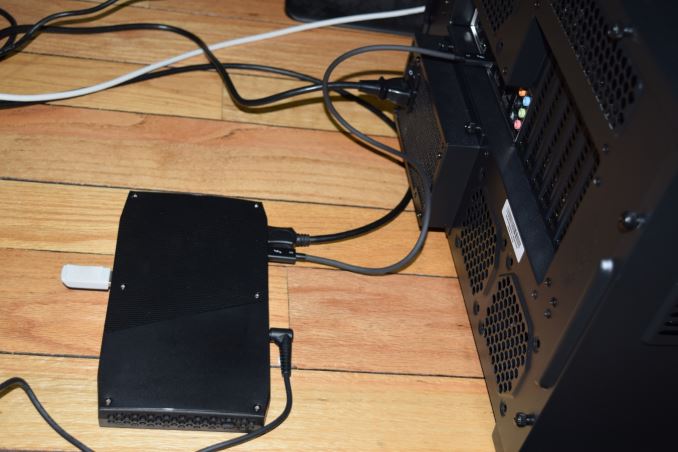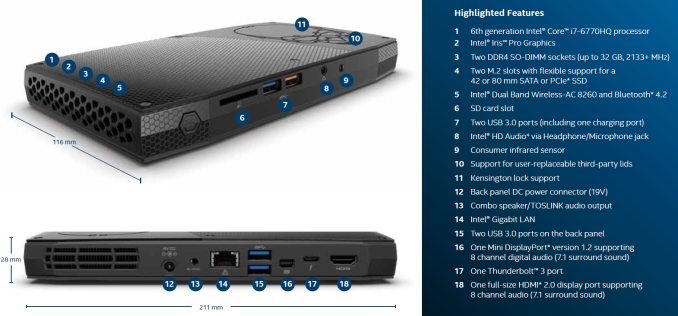The Intel Skull Canyon NUC6i7KYK mini-PC Review
by Ganesh T S on May 23, 2016 8:00 AM ESTMiscellaneous Aspects and Concluding Remarks
One of the more impressive aspects of the Skull Canyon NUC6i7KYK is the reappearance of Thunderbolt in a mini-PC. We have already covered Thunderbolt 3 in good detail. From the perspective of a Skull Canyon evaluation, the Thunderbolt 3 port does deserve a bit of attention. It must be noted that this USB Type-C port can also act as a USB 3.1 Gen 2 host port. Our evaluation of this feature is in two parts - we first hooked up a SanDisk Extreme 900 1.92TB USB 3.1 Gen 2 SSD and ran a quick speed test. We were able to see results similar to our review numbers, indicating that the USB 3.1 Gen 2 mode was indeed active. For the Thunderbolt part, we decided to check out Thunderbolt networking with our direct-attached storage testbed.
A Thunderbolt cable between two PCs is enough to create a Thunderbolt network
Connecting the Thunderbolt ports on the two machines and allowing the PCs to talk to each other automatically creates a 10Gbps network adapter. For a setup with just two machines, it is enough to just set static IPs on the interfaces of both machines in the same subnet, and setting the network location to private so that the machines can talk to each other. We configured a RAM drive on the testbed and mapped it as a network drive on the NUC6i7KYK, Running CrystalDiskMark on the mapped drive showed read speeds of 700 MBps and write speeds of 620 MBps, indicative of a 10Gbps link. The gallery below presents some screenshots of the benchmarks as well as the Thunderbolt networking setup steps.
Moving on to the business end of the review, let us get the complaints out of the way - While the size and form-factor of Skull Canyon are impressive, the acoustic profile is not that great. We would gladly trade a modest increase in the footprint of the system for lower fan noise. That said, the fan noise is in no way comparable to the BRIX Gaming lineup. It is just that it is not as silent as the traditional NUCs.
On the board layout front, we are unable to fathom why the CPU's PCIe lanes are not used at all. It would have been great to have a dual-port Alpine Ridge controller hang directly off the CPU's PCIe lanes. Finally, the ports on the chassis could have done with better spread. The two pairs of USB ports are such that one occupied port ends up making it difficult to utilize the other one in the pair. A port on one of the sides, or, on the lid (without relying on third-party designs), would be very welcome.
But with the above caveats in mind, Skull Canyon is definitely a great product. Simply put, it packs the most punch among systems with similar footprints. It is excellent for casual gamers, but, unfortunately, stops short of being a replacement for systems like the Zotac ZBOX MAGNUS EN970 or the ASRock VisionX 471D - two small form-factor PCs that integrate discrete GPUs at the cost of a larger footprint compared to Skull Canyon. The Thunderbolt 3 port, with an external GPU dock, can somewhat make up for the lack of a discrete GPU for gamers. However, the cost factor becomes a major issue. The 4C/8T configuration of the Core i7-6770HQ is also attractive to consumers looking for a small form-factor system with a powerful CPU, but, they must remember that some price premium is being paid for the Iris Pro graphics.
I am actually looking forward to what vendors like Zotac and ASRock can do with a similar design. If they could take a Skylake-H processor without Iris Pro (say, Core i7-6820HQ), and use the PCIe lanes off the CPU to hook up a mobile discrete GPU, it could deliver the best of both worlds - all the 45W TDP of the CPU can be used to provide raw processing power for CPU-intensive workloads, while a dGPU can handle graphics duties with a separate power budget.
To summarize, Intel has indeed managed to change the game with the NUC6i7KYK. A look at the increase in the gaming capabilities over the previous generation 'gaming' NUCs make the Skull Canyon updates to appear evolutionary in nature. However, the overall platform capabilities (including a much more powerful -H series CPU instead of a -U series CPU, as well as the integration of Thunderbolt 3 and dual M.2 PCIe 3.0 x4 SSD slots) are enough to justify the price premium ($650 for the barebones configuration).


















133 Comments
View All Comments
Ratman6161 - Tuesday, May 24, 2016 - link
True, but for the uses this machine would be well suited for, the i7 CPU is way overkill. Grandma and Grandpa would be well served by an i3jwcalla - Monday, May 23, 2016 - link
"What is the expected market for this?"There is none. Especially at that price.
JoeyJoJo123 - Monday, May 23, 2016 - link
I'd agree that it is overpriced by a fair margin, particularly compared to other mini-PCs on the market. Yeah, it does have the best CPU package amongst them, but you'd expect that to be mated with a good GPU solution as well. Given that the GPU solution is awful once it's fully configured (at a retail price of ~$1000 all together), there isn't much of a value.If it had two LAN ports, it'd have the niche of being a great PfSense or router box.
jecs - Tuesday, May 24, 2016 - link
I think this machine is great, not perfect or ideal, for light to medium graphic design work including web graphics. It is fast enough, small, look nice, once configured most designers won't open the machine ever, it can be used with an entry level profesional monitor, plug an external hard drive and add a great keyboard and mouse. It is not for me anyway, but I appreciate this initiative as in the future it may become powerful enough for more demanding work. If I can dream I wish it could have dual mobile high-end graphics and at least 32 gigs of memory, even if it gets bigger. With faster thunderbolt may be a hit. I will keep an eye on this form factor.FMinus - Sunday, August 7, 2016 - link
I've actually visited a cartoon animation studio the other year, of which 80% was running on Intel NUCs, think it was i5, and everyone had hooked a Wacom Cintiq to it and they worked like little bees, without much issues. They had more powerful machines for more demanding tasks and a render farm in the back, but most work was done on these little boxes.The reality is, if you're not playing video games, you really don't need a dedicated GPU for the majority tasks you do on a PC. That being said, this skull canyon part is interesting, yet overpriced in my opinion to really pick up.
oasisfeng - Tuesday, May 24, 2016 - link
I am buying this as a portable computer for software development, which can be put into pocket to be carried between office and home. I don't like laptop for software development due to constrained keyboard and display.BurntMyBacon - Tuesday, May 24, 2016 - link
Is there a reason you can't use the same display/keyboard you are using for the NUC on a laptop and at least get the benefit of a built in UPS? You'd also have a display and keyboard and the ability to run off the wall should you ever have an emergency, but I do understand your desire for a better keyboard/display. I feel its a bit too expensive for me, but I can still see some viable uses and you seem to have one. In any case, if you decide to get it, let us know how it works out for you.Gadgety - Monday, May 23, 2016 - link
Looks impressive for such a small integrated GPU package. Perhaps it's too early though as the GPU still doesn't have full HEVC 10b decoding for HTPC. Doesn't AMD's Carrizo, and upcoming Bristol Ridge sport this?monstercameron - Monday, May 23, 2016 - link
Carrizo only supports 8bit hevc, stoneyridge allegedly supports 10bit.Texag2010 - Monday, May 23, 2016 - link
Can you please add the Intel D54250WYKH nuc as an option to the comparative PC configuration? For people who are upgrading from the best nuc available back in the day...